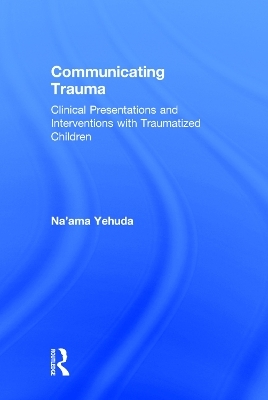
Communicating Trauma
Routledge (Verlag)
978-0-415-74309-9 (ISBN)
Communicating Trauma explores the various aspects of language and communication and how their development can be affected by childhood trauma and overwhelm. Multiple case-study vignettes describe how different kinds of childhood trauma can manifest in children's ability to relate, attend, learn, and communicate. These examples offer ways to understand, respond, and support children who are communicating overwhelm. In this book, psychotherapists, speech-language pathologists, social workers, educators, occupational and physical therapists, medical personnel, foster parents, adoption agencies, and other child professionals and caregivers will find information and practical direction for improving connection and behavior, reducing miscommunication, and giving a voice to those who are often our most challenging children.
Na’ama Yehuda, MSC, SLP, is a speech-language pathologist and audiologist with over 25 years’ experience. A clinician in private practice, she consulted for the New York City Department of Education; provides international professional development and consultations on communication, language, trauma, and development; and is the author of several publications on the topic. She was elected to serve on the boards of directors of the Israeli Speech Hearing Language Association (ISHLA) and the International Society for the Study of Trauma and Dissociation (ISSTD), chaired and volunteers on taskforces and committees, and co-chairs the Child and Adolescent Committee of ISSTD. She also writes and publishes fiction.
Part 1: A Brief Overview of Communication, Language, and Development 1. Infant Communication and Attachment: Reciprocity, Verbalization, and Regulation 2. Early Language Development: How Language Shapes Reality and Reality Shapes Communication 3. Socialization, Semantics, Humor, Symbolic Language, and Empathy Part 2: Trauma, Maltreatment, and Developmental Impact 4. Indirect Trauma: Medical, Intrauterine, Environmental and Societal Trauma 5. Maltreatment: Neglect and Abuse 6. The Neuroscience of Trauma, Emotional Regulation, and the Developing Self Part 3: The Language of Trauma 7. How Trauma Affects Language and Why It Matters So Much More in Children 8. Trauma’s Impact on Attention and Learning 9. Trauma’s Impact on Children’s Vocabulary and Semantics 10. Trauma’s Impact on Pragmatics: Language Use, Social Cues, and Discourse Rules 11. Trauma’s Impact on Memory, Organization, and Retrieval Part 4: When Communication Goes Awry: Clinical Presentation and Assessment Challenges 12. Communication Symptoms in Traumatized and Dissociative Children 13. History, Screening, and Assessment Indicators Part 5: Mending Meaning: Intervention Strategies, Collaboration, and the Importance of Taking Care 14. Psychoeducation and Everyday Tools for Reducing Overwhelm 15. Communication Intervention for Traumatized Children 16. The Promises and Challenges of Teamwork 17. Supporting the Supporters: Recognizing and Managing Secondary Traumatization Afterword: A Prognosis of Hope
| Verlagsort | London |
|---|---|
| Sprache | englisch |
| Maße | 152 x 229 mm |
| Gewicht | 640 g |
| Themenwelt | Geisteswissenschaften ► Psychologie ► Allgemeine Psychologie |
| Geisteswissenschaften ► Psychologie ► Biopsychologie / Neurowissenschaften | |
| Medizin / Pharmazie ► Gesundheitsfachberufe ► Logopädie | |
| Medizin / Pharmazie ► Medizinische Fachgebiete ► Notfallmedizin | |
| Medizin / Pharmazie ► Medizinische Fachgebiete ► Pädiatrie | |
| Medizin / Pharmazie ► Medizinische Fachgebiete ► Psychiatrie / Psychotherapie | |
| Sozialwissenschaften ► Pädagogik ► Sonder-, Heil- und Förderpädagogik | |
| Sozialwissenschaften ► Pädagogik ► Sozialpädagogik | |
| Sozialwissenschaften ► Soziologie | |
| ISBN-10 | 0-415-74309-5 / 0415743095 |
| ISBN-13 | 978-0-415-74309-9 / 9780415743099 |
| Zustand | Neuware |
| Haben Sie eine Frage zum Produkt? |
aus dem Bereich


